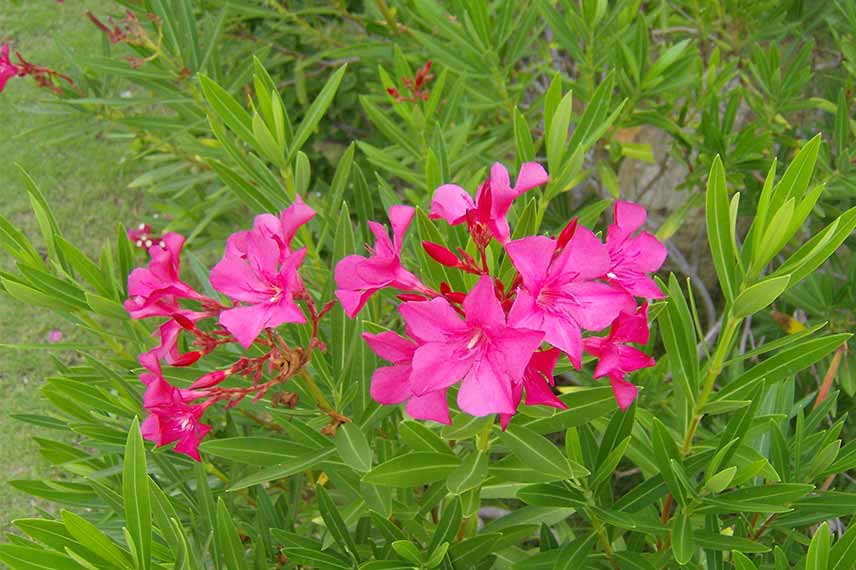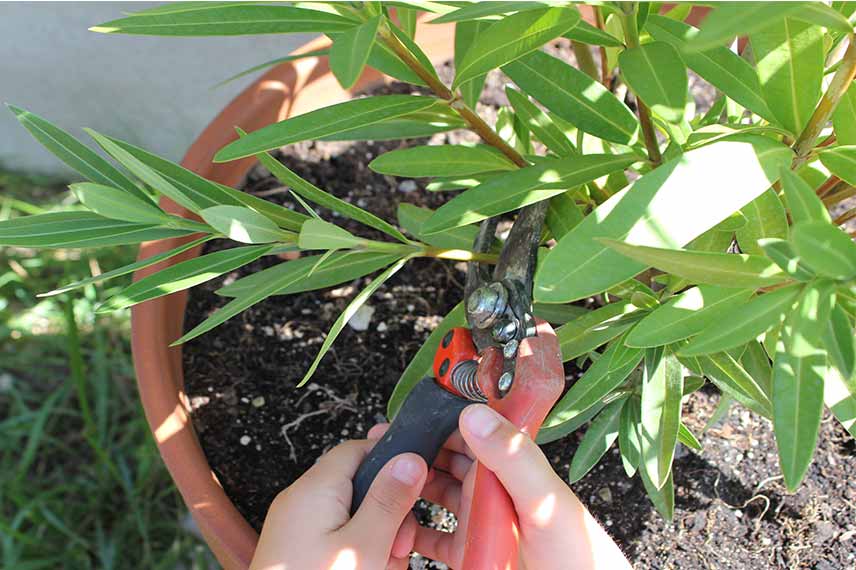The oleander (Nerium oleander) brings an exotic touch to the garden with its clusters of small flowers that appear from June to September and its bright green evergreen foliage. Whether grown in the ground, as a standalone specimen, in a hedge or in a pot on a balcony, pruning remains an important step to enjoy its magnificent summer flowering for many years.
Discover when and how to prune an oleander with our tutorial.

The summer flowering of the oleander enhances the garden. © Wilfredo Rodríguez-Public Domain
Why prune an Oleander?
Pruning an oleander helps maintain a beautiful compact and harmonious shape. Additionally, this pruning also stimulates flowering by encouraging the plant to produce new shoots. By removing dead or diseased branches, you also keep the plant healthy. And finally, pruning helps control its size, especially if it becomes a bit too invasive!
When to prune an oleander?
The Nerium flowers on the current year's wood with flowers at the ends of the branches, so pruning should be done every 4 to 5 years for those in the ground, every 2 years for those in containers or pots and in a non-severe manner.
For an oleander in the ground, the pruning period is in early spring, in April. But, you should prune just after flowering if the bush is in a pot or if you live in a region with a mild climate. In mild climates, you can prune the oleander until the end of September.
Important! Note that the bush must be at least 5 years old before starting to be pruned.
In August and September, use the cuttings to propagate new plants. To succeed in propagation by cuttings, check out our advice sheet: Propagating oleander: when and how, our advice.
How to prune an Oleander?
Necessary equipment
To prune the oleander, equip yourself with the following:
- a pair of gardening gloves, as the entire plant is toxic
- a clean and sharp secateurs for small branches
- a lopper for older branches
- a bag or bin for green waste
- a flexible tie
Step-by-step oleander pruning
Here are the keys to successfully pruning oleanders and maintaining an impeccable silhouette:
- Start by removing dead wood, diseased and old branches;
- Also cut off the last faded flowers;
- Pinch the young shoots at the tips;
- Cut branches that cross inside the bush to aerate it and prevent diseases or insects from settling in;
- Generally, cut branches by one-third of their length, as the branches need to be a certain length to bear flower buds;
- Dispose of the cuttings to avoid any contact with children or pets;
Be gentle, as if you prune too severely, you may compromise flowering.

Simple pruning for beautiful, well-flowered oleanders. © S.Chaillot
Special oleander pruning
How to train a standard oleander?
The standard oleander looks elegant on a balcony or terrace. Starting with a young bush, train it yourself from the early years and prune it annually. Here are the main steps for pruning a potted standard oleander:
- Place a stake in the oleander pot;
- Prune the lower branches by one-third of the height of the oleander;
- Tie the trunk to the stake;
- Keep the upper branches to form an irregular silhouette or a ball shape;
As it develops, remove any suckers that appear at the base or on the trunk and cut new branches that emerge along the height of the oleander. Gradually, you will form a standard bush with the desired silhouette.
How to prune a frost-damaged oleander?
Despite precautions, your oleander has suffered from frost. You notice that some branches have turned black and some leaves are scorched. Don't panic! In early spring, around March or April, cut off the blackened parts with clean secateurs and keep those that are still green. You can cut up to 10 cm from the base or precisely at the base if the frost has severely damaged the stems. As for damaged leaves, remove them. The branches and leaves will regrow, and the silhouette will fill out over a few years. Your oleander will thus have a second chance at life, and you can admire its magnificent summer flowering.
How to prune a bare-based oleander?
Whether grown in the ground or in a pot, the oleander can become bare at the base. To restore a beautiful silhouette and give it every chance to fill out, perform spring pruning once the frosts of the Ice Saints have passed (11, 12 and 13 May). With secateurs or loppers, depending on the stem diameter, cut back all branches by one-third, also removing dead or damaged stems. Then give your oleander time to grow and fill out. It may not flower the year of this pruning, but it will offer a multitude of flowers in the following summers.
To go further:
- Check out our advice sheet Oleander: planting, pruning and care and the range of colours available for oleanders.
- To choose the right plants, we recommend planting appropriately, don't hesitate to use our Plantfit web app!



































Comments